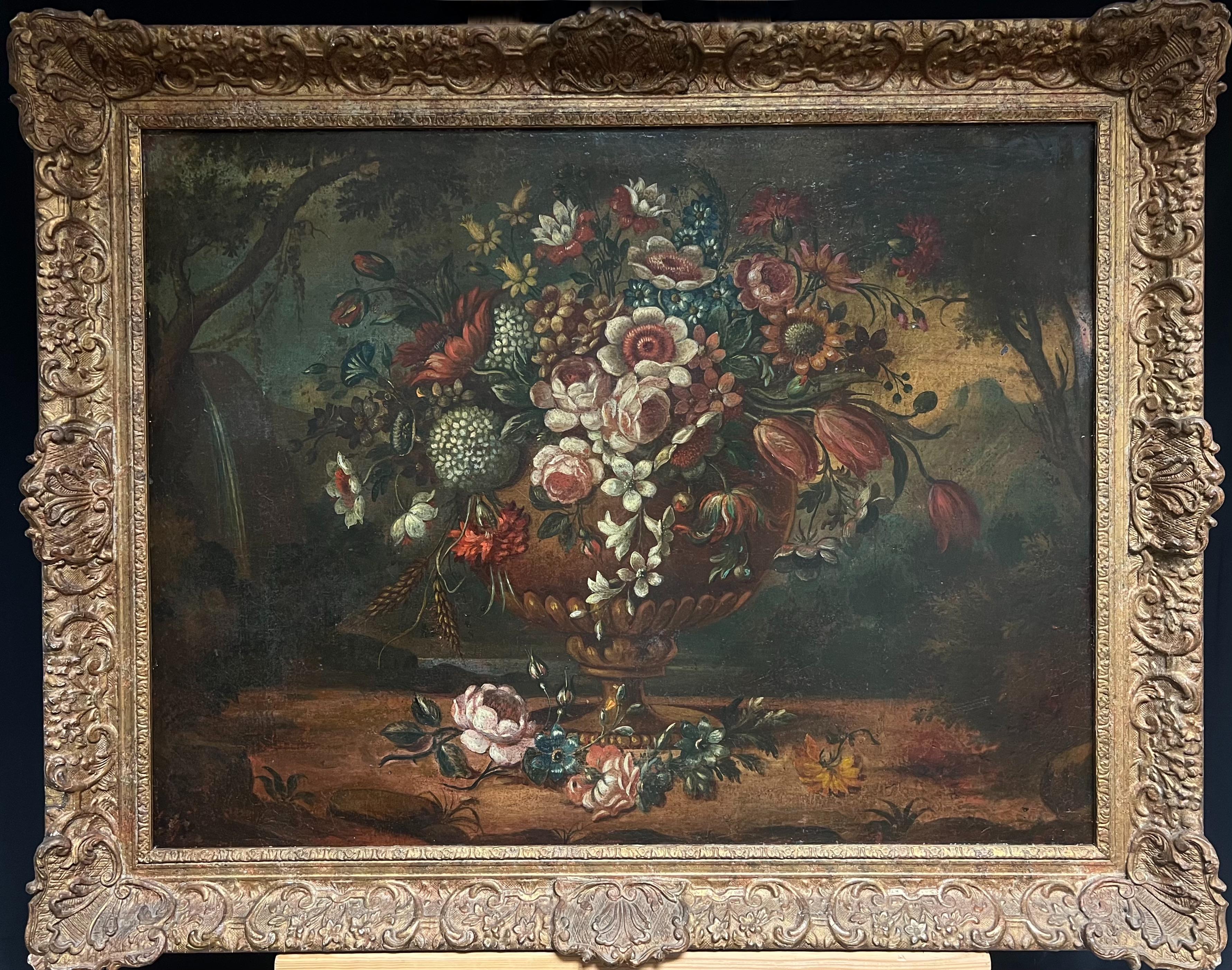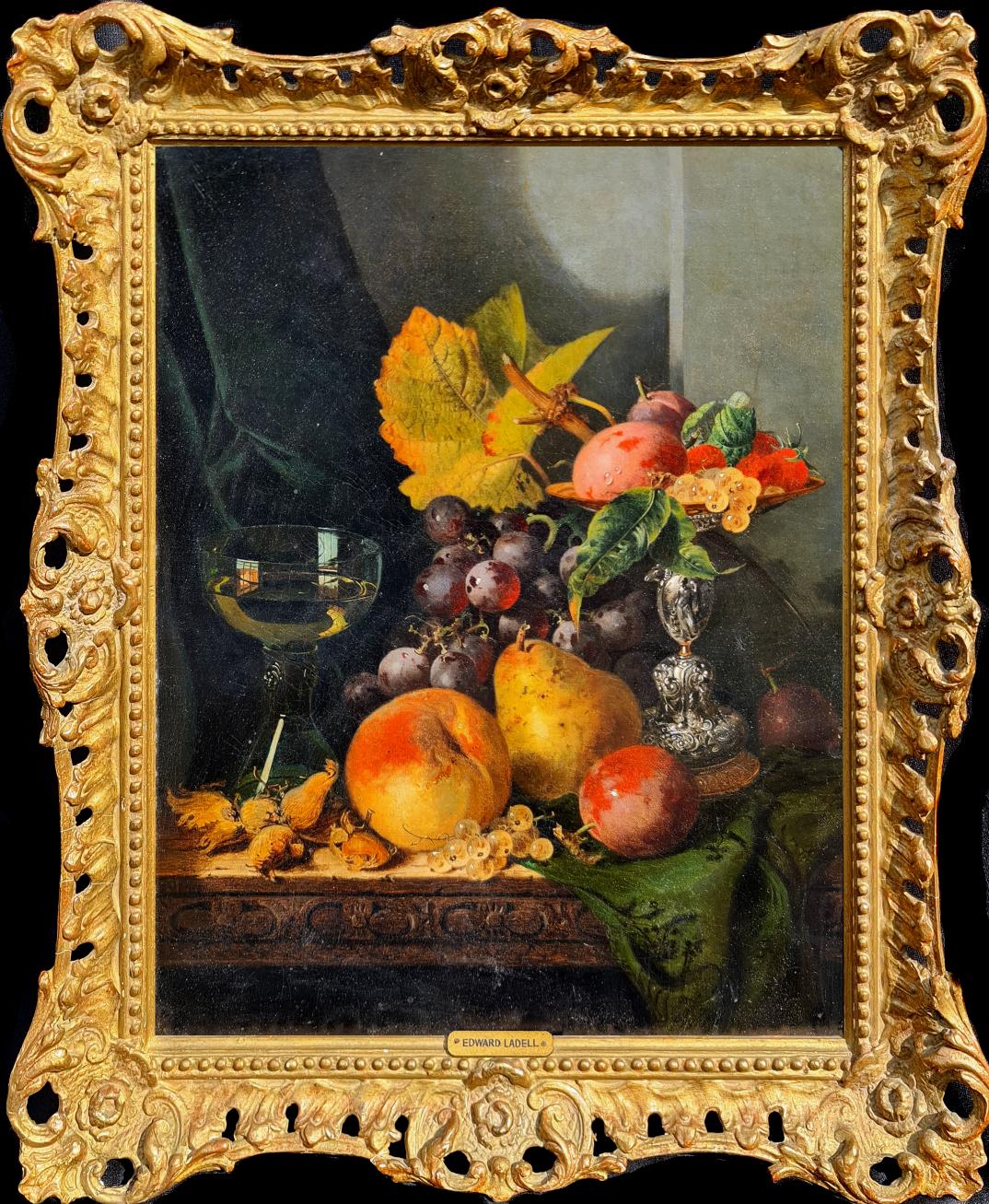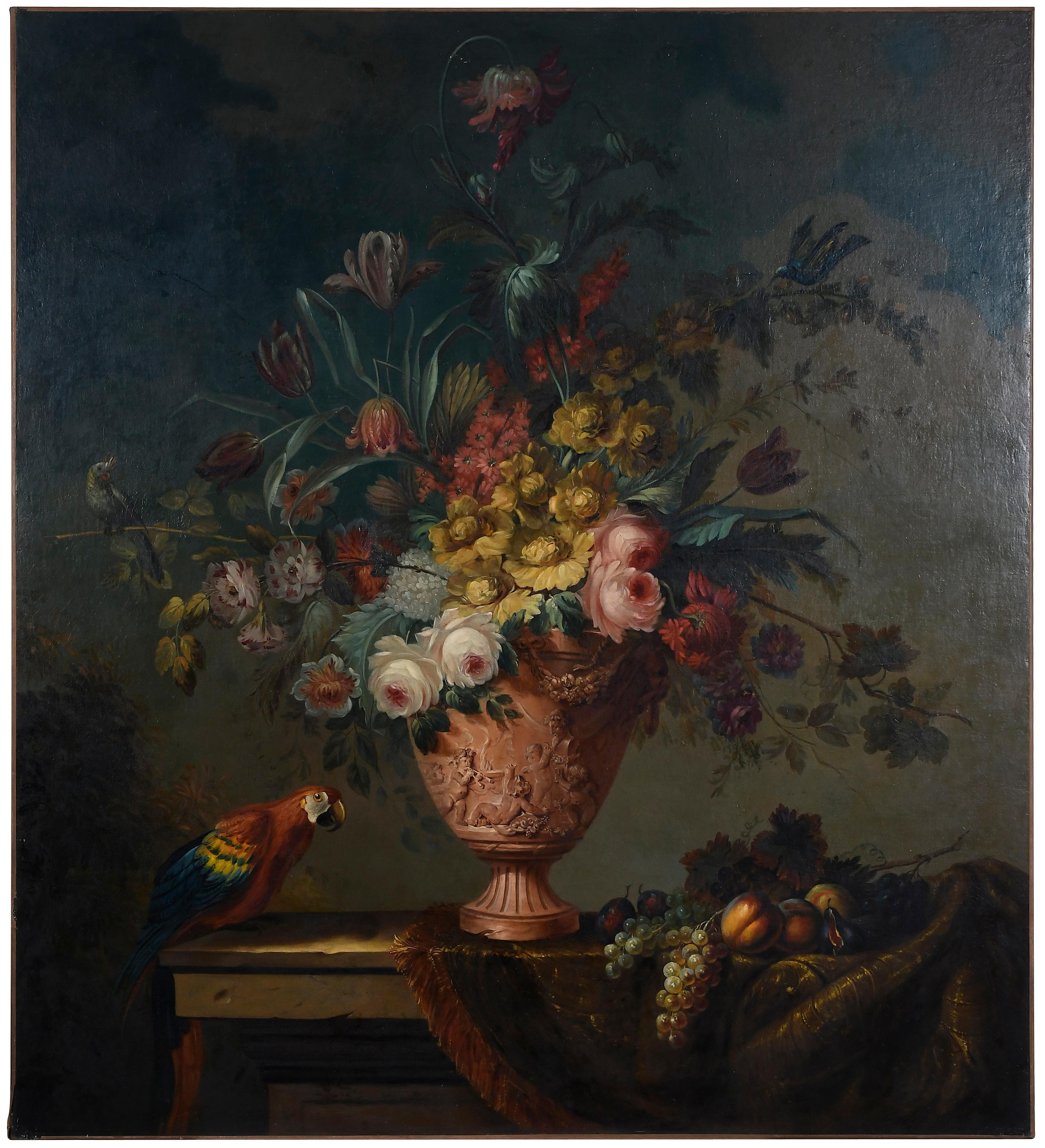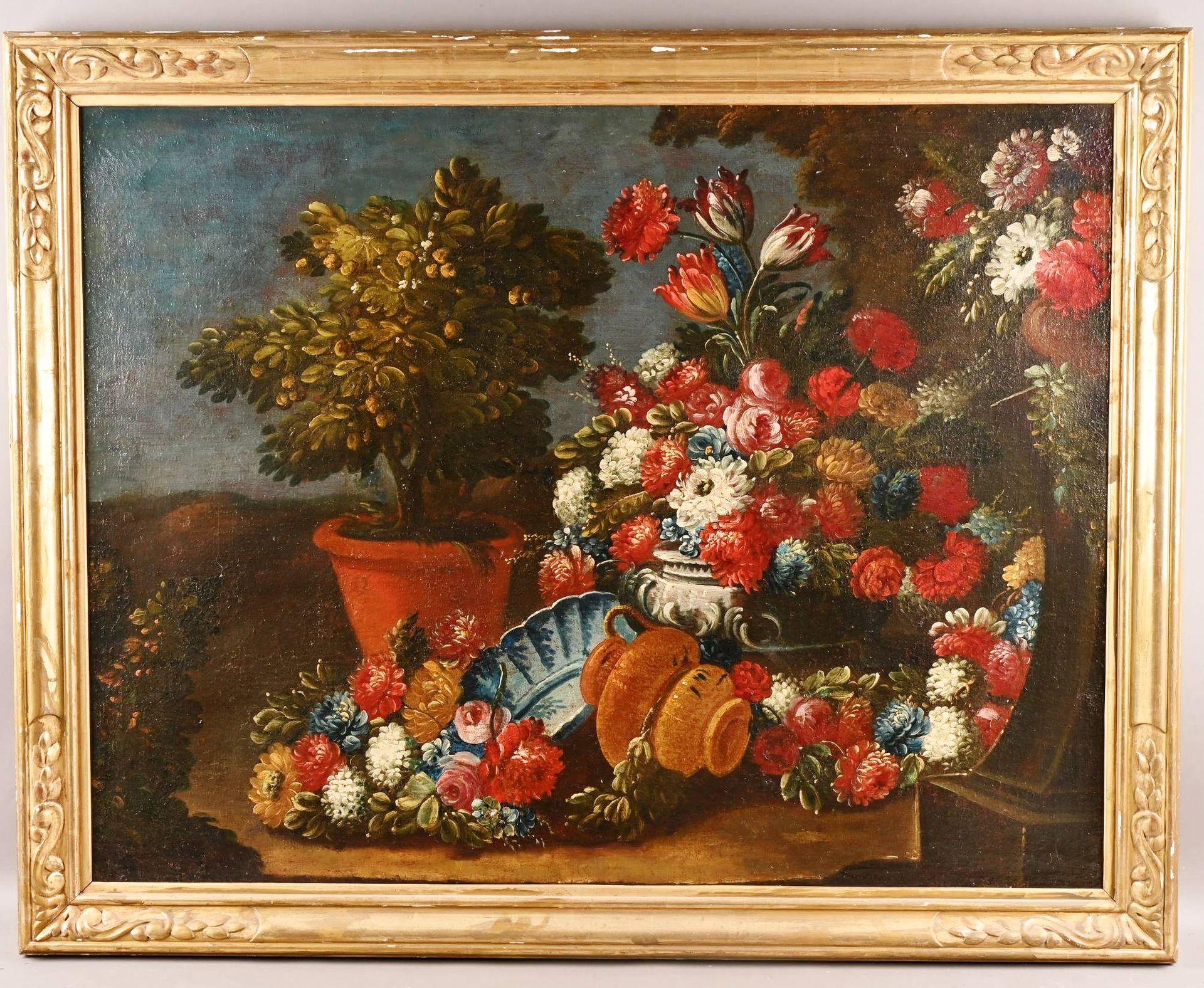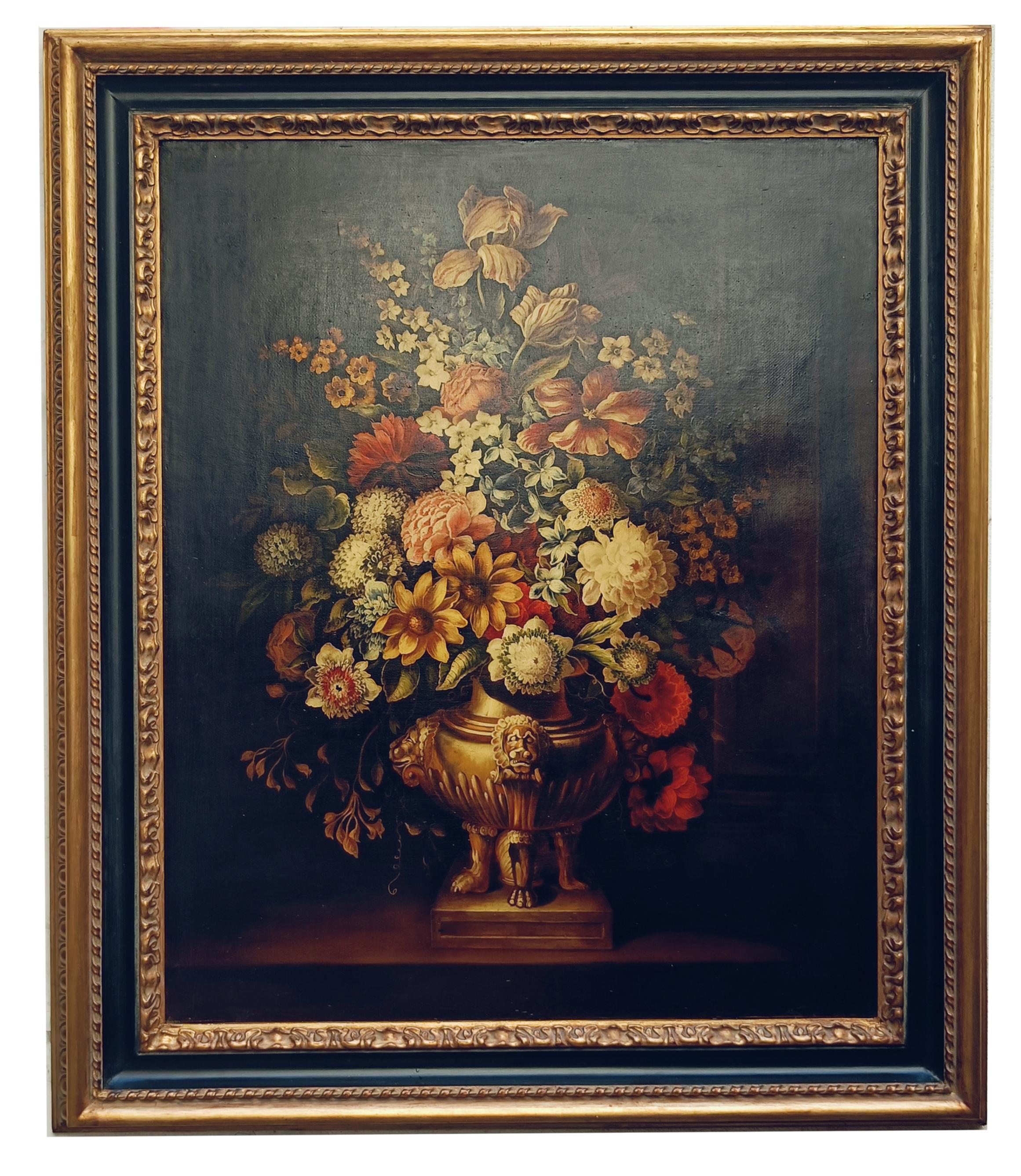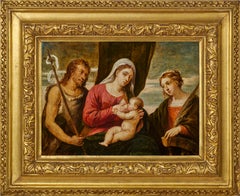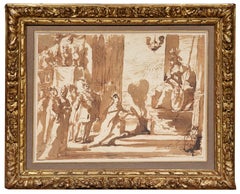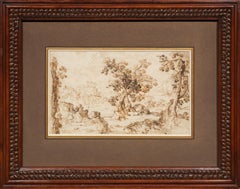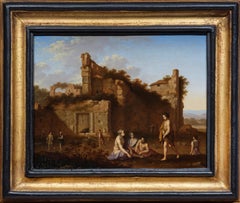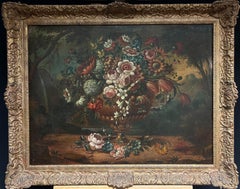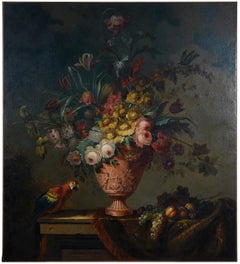Items Similar to Baroque silver Vase with Flowers with a Fruit Tray and a Clock by A. Zuccati
Want more images or videos?
Request additional images or videos from the seller
1 of 14
Adeodato ZuccatiBaroque silver Vase with Flowers with a Fruit Tray and a Clock by A. Zuccati2d half of the 17th century
2d half of the 17th century
$32,143.01
£23,891
€27,000
CA$44,380.65
A$49,214.87
CHF 25,858.76
MX$601,321.99
NOK 323,528.37
SEK 303,686.65
DKK 205,591.50
About the Item
This unpublished composition is a recent addition to Adeodato Zuccati’s catalog. The study of this painting by Gianluca Bocchi, an Italian art historian specializing in Italian still lives, is available upon request.
This composition is typical of the productions of Adeodato Zuccati, an Emilian painter of the second half of the XVII century recently rediscovered. Echoing the Roman compositions of the first half of the century, it presents us with a sumptuous bouquet of flowers, accompanied by a tray of fruits and a clock that reminds us of the brevity of life.
1. Adeodato Zuccati, a recently rediscovered artist
The dates of Adeodato Zuccati's birth and death are not known with certainty because historical sources have passed on little information about this artist. Zuccati was a painter of flowers active in Emilia-Romagna in the second half of the 17th century, his paintings are listed in the inventories of the collections of aristocratic families of Bologna, such as those of Count Annibale Ranuzzi (1697) and Giovanni Antonio Sedazzi (1700).
In the second half of the 17th century, Antonio Masini described him as an "expert in painting flowers in their natural state", recalling that he had been active since 1668. In the 18th century, Marcello Oretti said that he was "perhaps a pupil of Pier Francesco Cittadini, known as the Milanese", while admitting that he was not familiar with his works. In the 19th century, Pietro Zani described him as a "painter of flowers".
The rediscovery of the Basin of Flowers on a Carpet by Luigi Salerno in 1984 allowed us to begin the reconstruction of his corpus. Traces of this painting have since been lost and we have only an old black and white photograph. The painting bears an eighteenth-century inscription on the back: "Del Zuccati Pittor celebre di Bologna". Although this is not a signature, the indication immediately seemed plausible because it is consistent with the information provided by Masini and Zani on his botanical inclination: almost half of the painting illustrated by Luigi Salerno is in fact occupied by flowers resting on an elegant fabric.
A painter of flowers, Zuccati enriched his repertoire by staging sumptuous fabrics, fruits and pieces of silverware. It is obvious that Adeodato Zuccati was influenced in Bologna by Pier Francesco Cittadini, also called the Milanese (Milan 1616 - Bologna 1681), and we find in his art the tradition of the Roman still lives seen by Cittadini during his stay in the Eternal City around 1640. In conclusion we can say that Zuccati realizes a synthesis of the different pictorial traditions of the Po Valley which, starting from Pier Francesco Cittadini in Bologna, end up with Antonio Gianlisi the Younger (Rizzolo 1677 - Cremona 1727), a painter active between Piacenza and Cremona at the beginning of the 18th century.
2. Description of the artwork
The entire composition is illuminated by a light source to the left of the painting. A first table, set at a slight angle, is covered with a green velvet fringed with gold, on which a heavy orange brocade has been laid. The light enhances the contrast between these two colours and emphasises the folds of the brocade.
On this richly adorned table, in the centre of the composition, is a monumental table clock, which one imagines to be made of gilded and silvered bronze. The front of the clock is decorated with a statue of Athena, helmeted and armed with a spear and shield. An allegory of Justice, recognisable by its scales, crowns the aedicula. The slightly trapezoidal shape of the sides indicates that this composition was intended to be placed high up and could have been used as a doorway.
To the left of the clock is a silver tray in which three varieties of fruit are represented: grapes, peaches and figs. A curtain appears at the top of the composition, casting a studded leather box with a cup on it into shadow. On this bowl rest two long tulips that seem to be wilting and two glasses, rendered ghostly by the transparency of the pictorial material.
The entire right-hand side of the composition is taken up by an opulent bouquet of flowers in a baroque silver vase placed on a saddle below the sideboard. As is often the case in flower paintings, the painter has brought together species that bloom in different seasons: hyacinths and tulips, lilies and peonies, roses and orange blossoms.
The entire composition is animated by a ternary rhythm: three horizontal planes (from left to right, the sideboard with the table clock and the tray of fruit, the cup on the studded leather case and finally the saddle on which the bouquet of flowers is placed), three main motifs (the bouquet, the table clock and the fruit), three types of fruit in the tray.
While still lives no longer systematically have a symbolic value in the second half of the 17th century, it seems interesting to us to relate this ternary rhythm to the three ages of Man. Youth could be symbolised by the bouquet of flowers placed in full light, and maturity by the rich tray of fruit on the left. Finally, old age could be evoked by the enigmatic composition that we can barely make out in the shadows: two tulips placed on the cup and two glasses, already half erased by time, whose inexorable march is recalled by the predominant presence of the table clock.
The figure of Athena could be interpreted as an exhortation to wisdom, which is necessary to lead one's life with dignity, while the Justice that surmounts the aedicula reminds us that our actions will be judged at the end of time.
3. Related work
It seems interesting to us to relate this painting to two other works by Adeodato Zuccati.
The first one is kept at the Galleria Estense in Modena and comes from the Palazzo Ducale of the same city. This painting seems interesting to us because we find two glasses on a tray in the lower right that are very similar to those presented in the upper left of our painting, half hidden in the shadow of the curtain.
The second (last photo in our gallery), presented for sale at Dorotheum in Vienna (October 12, 2011 - lot 434 - 30,000 euros with expenses) is particularly interesting. Bearing almost the same dimensions (91.5 x 143 cm) this painting has a very similar composition but on an inverted basis as if it were a counterpart to our painting. The large vase with flowers on a stone pedestal is on the left, the center and the right of the painting are occupied by a table covered with an Ottoman carpet on which, among other things, a baroque bronze statue and various pieces of silverware are placed. A curtain drapes the upper right corner of the painting.
The composition is again tripartite and offers a very similar combination of colors. The green of the curtain perfectly matches that of the tablecloth in our painting. The brightness of the silverware echoes those of the large baroque vase in which the bouquet is placed. The bright red of the fabrics, the brown with golden reflections of the bronze statuette evoke the clock with the effigy of Athena and the draperies of the brocade placed below.
- Creator:Adeodato Zuccati (Italian)
- Creation Year:2d half of the 17th century
- Dimensions:Height: 41.32 in (104.96 cm)Width: 61.44 in (156.06 cm)
- Medium:
- Movement & Style:
- Period:Late 17th Century
- Condition:35 1/8”x 55 1/8”(89 x 140 cm) (41 5/16”x 61 7/16” - 105 x 156 cm framed) Provenance : Country Estate in Aveyron (Occitanie - France) Italian 17th century carved and gilded frame Please contact the seller for additional shipping proposals.
- Gallery Location:PARIS, FR
- Reference Number:1stDibs: LU1568211769272
About the Seller
5.0
Vetted Professional Seller
Every seller passes strict standards for authenticity and reliability
Established in 2020
1stDibs seller since 2021
10 sales on 1stDibs
Typical response time: 3 hours
- ShippingRetrieving quote...Shipping from: PARIS, France
- Return Policy
Authenticity Guarantee
In the unlikely event there’s an issue with an item’s authenticity, contact us within 1 year for a full refund. DetailsMoney-Back Guarantee
If your item is not as described, is damaged in transit, or does not arrive, contact us within 7 days for a full refund. Details24-Hour Cancellation
You have a 24-hour grace period in which to reconsider your purchase, with no questions asked.Vetted Professional Sellers
Our world-class sellers must adhere to strict standards for service and quality, maintaining the integrity of our listings.Price-Match Guarantee
If you find that a seller listed the same item for a lower price elsewhere, we’ll match it.Trusted Global Delivery
Our best-in-class carrier network provides specialized shipping options worldwide, including custom delivery.More From This Seller
View AllVirgin and Child, a paiting by David Teniers the Younger after Palma Vecchio
By David Teniers the Younger
Located in PARIS, FR
Provenance:
Dukes of Marlborough Collection, Blenheim Palace until its sale at Christie's London on 26 July 1886 (lot 172)
English private collection until its sale at Christie's London on 11 December 1992 (lot 363)
Erna Weidinger Collection (1923 - 2021) - Austria
Literature :
Georg Scharf - A list of the pictures in Blenheim Palace - Catalogue raisonné Part 2 - London 1862 (page 166 - number 199 "after Palma Giovane")
Charles Davies...
Category
1750s Old Masters Figurative Paintings
Materials
Oak, Oil
Allegory of the Treaty of Angoulême, a drawing attributed to Donato Mascagni
Located in PARIS, FR
We would like to thank Mrs. Ursula Verena Fischer Pace for suggesting the attribution to Donato Arsenio Mascagni.
We were immediately seduced by the rich tonalities of this allegory...
Category
1620s Old Masters Figurative Drawings and Watercolors
Materials
Ink
Rocky Landscape with Trees and Temple Ruins a drawing by Giulio Parigi (ca 1615)
Located in PARIS, FR
This Rocky Landscape with Trees and the Ruins of a Temple is a drawing by Giulio Parigi, an eclectic and prolific artist of the Medici court. An engraver, architect, furniture and je...
Category
1610s Old Masters Landscape Drawings and Watercolors
Materials
Ink, Laid Paper, Pen
Gathering in antique Ruins, a monogrammed painting by Jan van Haensbergen
By Jan Van Haensbergen
Located in PARIS, FR
Jan van Haensbergen was a painter of the Dutch Golden Age and a pupil of Cornelius van Poelenburgh (Utrecht 1594 - 1667). The painting we are presenting is inspired by Poelenburgh’s landscapes from his Italian sojourn. The dreamlike atmosphere of this Gathering in antique ruins appealed to us. Against a backdrop of antique ruins, three draped characters (perhaps bathers) are sitting in a circle, greeting a fourth character walking towards them.
Their tranquility contrasts with the bustle of the other characters in the background. They constitute a vivid illustration of otium, this leisure time that allows us to realize our full potential. With this Arcadian landscape, Jan van Haensbergen invites us in turn to leave the hustle and bustle of everyday life behind, to take a break, to enjoy the present moment chatting with close friends…
1. Jan van Haensbergen, a landscape and portrait painter of the Dutch Golden Age
Jan van Haensbergen was born in 1642 in Gorinchem, a town in southern Holland to the east of Rotterdam. He was a pupil of Cornelius van Poelenburgh, and began by painting landscapes inspired by those of his master, in an Italianate style. Between 1668 and 1669, he was registered at the Guild of Saint Luke in Utrecht.
In 1669, he moved to The Hague, where he joined the Confrérie Pictura, an artist society founded in 1656. His portraits, which became his main activity as a painter after settling in The Hague, were strongly influenced by Caspar Netscher (Prague or Heidelberg 1639 - The Hague 1684), whom he met in The Hague and whose son Constantijn became his son-in-law by marrying his daughter Magdalena.
In addition to his work as an artist, Van Haensbergen was also an art dealer, probably helped by his appointment as Dean of the Confrérie Pictura, where he also teached.
2. Description of the artwork and related paintings
This painting seems to us to be a kind of allegory of otium, that quiet bliss promised by Epicurus. It might even evoke an Epicurean proverb: "It is better to lie on the naked ground and be at ease, than to have a golden carriage and a rich table and be worried" .
Three draped young people - two men and a woman in the background - are seated in a circle, greeting a fourth figure walking towards them, hair disheveled and body draped in a towel as if drying off after a bath, indicating the need for prior purification to fully enjoy this rest. Their nonchalance contrasts with the bustle of the various characters in the background.
The composition is punctuated by successive diagonals, and opens onto a landscape on the right, with a succession of mountainous planes. This painting is typical of the Italianate works produced by Van Haensbergen in the 1660s under the influence of Cornelis van Poelenburgh...
Category
17th Century Old Masters Landscape Paintings
Materials
Oak, Oil
Judith and Salome, a pair of oil paintings on canvas by Francesco Conti
Located in PARIS, FR
This widely referenced pair of paintings is one of Francesco Conti’s most successful productions. Francesco Conti is one of the finest painters of 18th-century Florence. In the shimmering colors typical of his best work, he represents two opposite characters from the Bible: the virtuous Judith, whose courage saves her people by cutting off the head of the invader Holofernes, and the depraved Salome, who under the influence of her mother becomes responsible for the beheading of the prophet John the Baptist.
The artist's talent lies in his ability to treat these two macabre subjects with a light touch, presenting us with two attractive women who seem to twirl with glee amidst the severed heads...
1. Francesco Conti, the “Florentine Tiepolo”
Francesco Conti is a major painter of the Florentine school of the 18th century; he can even probably be considered, along with Giovanni Domenico Ferretti (1692-1768), as one of the two main painters of the second quarter of the Florentine 18th century.
Born in Florence in 1682, Francesco Conti began his apprenticeship in the workshop of Simone Pignoni (1611 - 1698), a disciple of Francesco Furini; he was also influenced by the Venetian Sebastiano Ricci. A protégé of Marquis Riccardi, he accompanied him to Rome between 1699 and 1705, where he frequented Carlo Maratta's studio. He settled permanently in Florence in 1705.
Painted exclusively on canvas, the majority of his work consists of religious subjects, altarpieces or private devotional works. It is likely that Conti himself was a devout churchgoer, as evidenced by his affiliation, in the third decade of the eighteenth century, to the Society of the Disciples of Saint-John-the-Baptist, and his entry, at the end of his life, into the fraternity of the Venerable Society of the Holy Trinity.
In Florence, Conti worked for the Grand Duchy's major patrons, including the last Medici - in particular Giangastone and Annamaria Luisa, Electress Palatine - and confirmed his role as a reference painter under the Lorraine Regency, as master of the Public Drawing School, which was closely linked to the institute responsible for the manufacture of semi-precious stone mosaics, then located in the Uffizi complex.
Matteo Marangoni, an art critic of the early 20th century, praised his "brushwork full of elegance and true spirit of the 18th century", pointing out that Conti was "probably one of the best colorists" of the Florentine school of his time. These two characteristics led the art historian Paolo dal Poggetto to nickname him the "Florentine Tiepolo".
2. Judith and Salome, two biblical characters opposing each other
These two paintings form a pair presenting two biblical episodes, which have in common the depiction of a "heroine" carrying the severed head of a man.
While the Salome episode might at first appear to be an echo of the Old Testament story of Judith, each character is the exact opposite of the other. Judith, whose story is told in the Book of Judith, is a beautiful young widow from Bethulia who, accompanied by her maid, went into the camp of the invading Assyrians and won the confidence of Holofernes, the general commanding the enemy army. Invited to a great feast on the fourth evening, she took advantage of Holofernes' drunkenness to cut off his head. “She went up to the bedpost near Holofernes’ head, and took down his sword that hung there. She came close to his bed, took hold of the hair of his head, and said, “Give me strength today, O Lord God of Israel!” Then she struck his neck twice with all her might, and cut off his head. Next she rolled his body off the bed and pulled down the canopy from the posts. Soon afterward she went out and gave Holofernes’ head to her maid, who placed it in her food bag...
Category
1710s Old Masters Figurative Drawings and Watercolors
Materials
Canvas, Oil
Macbeth and the Three Witches a Painting on Panel by Francesco Zuccarelli
By Francesco Zuccarelli
Located in PARIS, FR
This painting, created during Zuccarelli's stay in England, represents the decisive moment when Macbeth, together with Banquo, meets the three witches who announce that he will be Ki...
Category
1760s Old Masters Landscape Paintings
Materials
Oil, Wood Panel
You May Also Like
STILL LIFE WITH FLOWER FRUIT AND BIRDS - Oil on canvas Italy Alfredo Mayeux
Located in Napoli, IT
Oil painting on canvas - Composition of flowers in a metal vase with fruit, and landscape in the background - Alfredo Mayeux; early XX century.
Category
Mid-20th Century Old Masters Still-life Paintings
Materials
Canvas, Oil
18th-Century Baroque Oil Still Life Flowers Floral Arrangement in an Ornate Urn
Located in Cirencester, Gloucestershire
Elaborate Floral Arrangement
French artist, 18th Century
oil on canvas, framed
Framed: 27 x 34 inches
Canvas: 22 x 29 inches
Provenance: private collection, England
Condition: very...
Category
Mid-18th Century Baroque Still-life Paintings
Materials
Oil, Canvas
Still life with Silver Tazza, Glass Roemer and Fruit
By Edward Ladell
Located in Belgravia, London, London
Oil on canvas
Canvas size: 17 x 14 inches
Framed size: 18 x 21 inches
Signed lower right
Category
19th Century Still-life Paintings
Materials
Canvas, Oil
Opulent Still Life with Flowers, Fruit, Vase & Parrot Old Master Rococo French
By Jean-Baptiste Monnoyer
Located in Atlanta, GA
This lavish still life reflects the height of Baroque and Rococo aesthetics, where opulence, abundance, and the celebration of nature were central themes. The asymmetrical bouquet, b...
Category
18th Century Baroque Still-life Paintings
Materials
Canvas, Oil
Huge 18th Century Italian Oil Still Life Classical Flowers Ornamental Setting
Located in Cirencester, Gloucestershire
Ornamental Flowers in a Classical Still Life Composition
Italian School, circa 1780's period
oil painting on canvas: 32 x 42 inches
antique gilt frame: 38 x 48 inches
condition: over...
Category
Late 18th Century Baroque Still-life Paintings
Materials
Canvas, Oil
FLOWERS - In the manner of A.Bosschaer Oil on Canvas Italian Still Life Painting
By Carlo De Tommasi
Located in Napoli, IT
Flowers - Oil on canvas cm. 100x80, Carlo De Tommasi, Italy, 2009.
The painting is inspired by one of the canvases of the Belgian painter Ambrosius Bosschaert...
Category
Early 2000s Flemish School Still-life Paintings
Materials
Cotton Canvas, Oil
More Ways To Browse
Antique Silver Vase
Baroque Flowers
Silver Flower Painting
Old Master Still Life Of Flowers
Fruit With Flowers Oil Painting
Italian Fruit Painting
19th Fruit Still Life
Folding Clock
Fruit Tray
Folding Photo Frame
Roman Baroque Painting
Fruit On Table Art
Ottoman Painting
Still Life Fruit Vase
Fruit Botanicals
Antique Painting Clock
Antique Master Clock
Still Life Fruit Oil Painting 19th Century

